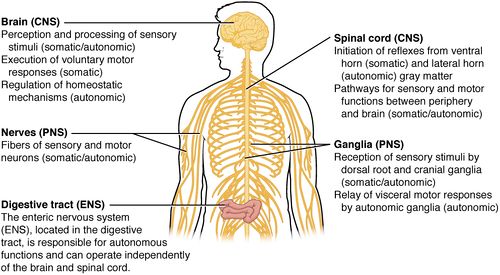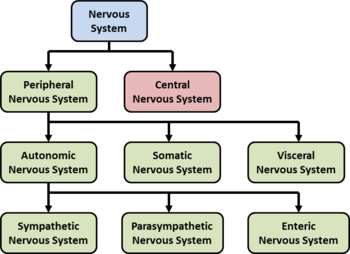Nervous system: Difference between revisions
(→See also: renamed il) |
(hite matter */) |
||
| (38 intermediate revisions by one other user not shown) | |||
| Line 1: | Line 1: | ||
The nervous system is the part of an animal's body that coordinates its voluntary and involuntary actions and transmits signals to and from different parts of its body. [[Neuroinflammation]], [[autonomic nervous system]] dysfunction, and [[intracranial hypertension]] are all thought to contribute to the symptoms of [[ME]]. | The nervous system is the part of an animal's body that coordinates its voluntary and involuntary actions and transmits signals to and from different parts of its body. [[Neuroinflammation]], [[autonomic nervous system]] dysfunction, and [[intracranial hypertension]] are all thought to contribute to the symptoms of [[myalgic encephalomyelitis|ME]]. | ||
[[File:Components of the Nervous System.png|350px|thumb|right|Divisions of the nervous system]] | [[File:Components of the Nervous System.png|350px|thumb|right|Divisions of the nervous system]] | ||
[[File:Nervous System.png|350px|thumb|right|Diagram of the Human Nervous System]] | [[File:Nervous System.png|350px|thumb|right|Diagram of the Human Nervous System]] | ||
==Divisions of the nervous system== | ==Divisions of the nervous system== | ||
===Central nervous system=== | ===Central nervous system=== | ||
The [[central nervous system]] (CNS) is the part of the nervous system consisting of the [[brain]] and [[spinal cord]]. The central nervous system is so named because it integrates information it receives from, and coordinates and influences the activity of, all parts of the bodies of bilaterally symmetric animals — that is, all multicellular animals except sponges and radially symmetric animals such as jellyfish — and it contains the majority of the nervous system. | The [[central nervous system]] (CNS) is the part of the nervous system consisting of the [[brain]] and [[spinal cord]]. The central nervous system is so named because it integrates information it receives from, and coordinates and influences the activity of, all parts of the bodies of bilaterally symmetric animals — that is, all multicellular animals except sponges and radially symmetric animals such as jellyfish — and it contains the majority of the nervous system. | ||
[[File:1205 Somatic Autonomic Enteric StructuresN (1).jpg|500px|thumb|right|]] | [[File:1205 Somatic Autonomic Enteric StructuresN (1).jpg|500px|thumb|right|'''Somatic, Autonomic and Enteric Structures of the Nervous System.'''<br>{{Cite book | | ||
last=Betts | first = JG | authorlink = | last2 = Young | first2 = KA | authorlink2 = | last3 = Wise | first3 = JA | last4 = Johnson | first4 = E | last5 = Poe | first5 = B | last6 = Kruse | first6 = DH | last7 = Korol | first7 = O | last8 = Johnson | first8 = JE | last9 = Womble | first9 = M | last10 = DeSaix | first10 = P | |||
| date = Apr 25, 2013 | website = OpenStax|location=Houston, Texas|language=en|archive-url=|archive-date=|url-status= | title = Anatomy and Physiology | url=https://openstax.org/books/anatomy-and-physiology/pages/1-introduction | |||
|chapter=12.1 Basic Structure and Function of the Nervous System | |||
|chapter-url=https://openstax.org/books/anatomy-and-physiology/pages/12-1-basic-structure-and-function-of-the-nervous-system | |||
|access-date=2022-01-30}}<ref name="12-1-NervousSystem">{{Cite book | | |||
last=Betts | first = JG | authorlink = | last2 = Young | first2 = KA | authorlink2 = | last3 = Wise | first3 = JA | last4 = Johnson | first4 = E | last5 = Poe | first5 = B | last6 = Kruse | first6 = DH | last7 = Korol | first7 = O | last8 = Johnson | first8 = JE | last9 = Womble | first9 = M | last10 = DeSaix | first10 = P | |||
| date = Apr 25, 2013 | website = OpenStax|location=Houston, Texas|language=en|archive-url=|archive-date=|url-status= | title = Anatomy and Physiology | url=https://openstax.org/books/anatomy-and-physiology/pages/1-introduction | |||
|chapter=12.1 Basic Structure and Function of the Nervous System | |||
|chapter-url=https://openstax.org/books/anatomy-and-physiology/pages/12-1-basic-structure-and-function-of-the-nervous-system | |||
|access-date=2022-01-30}}</ref>]] | |||
===Peripheral nervous system=== | ===Peripheral nervous system=== | ||
The [[peripheral nervous system]] (PNS) is the part of the nervous system that consists of the nerves and ganglia on the outside of the brain and spinal cord. The main function of the PNS is to connect the central nervous system (CNS) to the limbs and organs, essentially serving as a communication relay going back and forth between the brain and spinal cord with the rest of the body. Unlike the CNS, the PNS is not protected by the bone of spine and skull, or by the [[Blood-brain barrier|blood–brain barrier]], which leaves it exposed to toxins and mechanical injuries. The peripheral nervous system is divided into the somatic nervous system and the autonomic nervous system; some textbooks also include sensory systems. | The [[peripheral nervous system]] (PNS) is the part of the nervous system that consists of the nerves and ganglia on the outside of the brain and spinal cord. The main function of the PNS is to connect the central nervous system (CNS) to the limbs and organs, essentially serving as a communication relay going back and forth between the brain and spinal cord with the rest of the body. Unlike the CNS, the PNS is not protected by the bone of spine and skull, or by the [[Blood-brain barrier|blood–brain barrier]], which leaves it exposed to toxins and mechanical injuries. The peripheral nervous system is divided into the somatic nervous system and the autonomic nervous system; some textbooks also include sensory systems. | ||
| Line 22: | Line 28: | ||
===Parasympathetic nervous system=== | ===Parasympathetic nervous system=== | ||
The [[parasympathetic nervous system]] (usually abbreviated PSNS, not PNS, to avoid confusion with the peripheral nervous system [PNS]) is one of the two divisions of the autonomic nervous system, the other | The [[parasympathetic nervous system]] (usually abbreviated PSNS, not PNS, to avoid confusion with the peripheral nervous system [PNS]) is one of the two divisions of the autonomic nervous system, the other fight-or-flight response. | ||
===Somatic | ===Somatic system=== | ||
skin. | |||
=== | === system === | ||
=== | === system === | ||
== | ==system== | ||
===Neuron=== | ===Neuron=== | ||
===Interneuron=== | ===Interneuron=== | ||
===Ganglion=== | ===Ganglion=== | ||
===Nerve=== | ===Nerve=== | ||
=== | ===matter=== | ||
=== | ===matter=== | ||
=== | ===cell=== | ||
=== | ===Potential=== | ||
===Synapse=== | ===Synapse=== | ||
===Neurotransmitter=== | ===Neurotransmitter=== | ||
=== | ===receptor=== | ||
== | ==ME/CFS== | ||
== | ==studies== | ||
== | ==more== | ||
* [ | * [[wikipedia:Outline_of_the_human_nervous_system|System]] | ||
* | *Youtube | ||
* | * [[Central nervous system|ral Nervous System]]) | ||
* | * [[Parasympathetic nervous system|System]]) | ||
* | * [[Sympathetic nervous system|System]]) | ||
* | * [[Autonomic nervous system|System]]) | ||
== | ==also== | ||
*[[Autonomic nervous system]] | *[[Autonomic nervous system|system]] | ||
*[[Central nervous system]] | *[[Central nervous system|system]] | ||
*[[Dorsal root ganglia]] | *[[Dorsal root ganglia|ganglia]] | ||
*[[Microglia]] | *[[Microglia]] | ||
*[[Neurology of ME/CFS]] | *[[Neurology of ME/CFS|ME/CFS]] | ||
* | * | ||
== References == | |||
{{Reflist}} | |||
[[Category:Body systems]] | [[Category:Body systems]] | ||
[[Category:Neurology]] | [[Category:Neurology]] | ||
Latest revision as of 07:15, January 15, 2024
The nervous system is the part of an animal's body that coordinates its voluntary and involuntary actions and transmits signals to and from different parts of its body. Neuroinflammation, autonomic nervous system dysfunction, and intracranial hypertension are all thought to contribute to the symptoms of ME.
Divisions of the nervous system[edit | edit source]
Central nervous system[edit | edit source]
The central nervous system (CNS) is the part of the nervous system consisting of the brain and spinal cord. The central nervous system is so named because it integrates information it receives from, and coordinates and influences the activity of, all parts of the bodies of bilaterally symmetric animals — that is, all multicellular animals except sponges and radially symmetric animals such as jellyfish — and it contains the majority of the nervous system.

Betts, JG; Young, KA; Wise, JA; Johnson, E; Poe, B; Kruse, DH; Korol, O; Johnson, JE; Womble, M; DeSaix, P (April 25, 2013). "12.1 Basic Structure and Function of the Nervous System". Anatomy and Physiology. OpenStax. Houston, Texas. Retrieved January 30, 2022.[1]
Peripheral nervous system[edit | edit source]
The peripheral nervous system (PNS) is the part of the nervous system that consists of the nerves and ganglia on the outside of the brain and spinal cord. The main function of the PNS is to connect the central nervous system (CNS) to the limbs and organs, essentially serving as a communication relay going back and forth between the brain and spinal cord with the rest of the body. Unlike the CNS, the PNS is not protected by the bone of spine and skull, or by the blood–brain barrier, which leaves it exposed to toxins and mechanical injuries. The peripheral nervous system is divided into the somatic nervous system and the autonomic nervous system; some textbooks also include sensory systems.
Autonomic nervous system[edit | edit source]
The autonomic nervous system (ANS) is a division of the peripheral nervous system that influences the function of internal organs. The autonomic nervous system is a control system that acts largely unconsciously and regulates bodily functions such as the heart rate, digestion, respiratory rate, pupillary response, urination, and sexual arousal. This system is the primary mechanism in control of the fight-or-flight response and the freeze-and-dissociate response
Sympathetic nervous system[edit | edit source]
The sympathetic nervous system is one of the two main divisions of the autonomic nervous system, the other being the parasympathetic nervous system. The autonomic nervous system functions to regulate the body's unconscious actions. The sympathetic nervous system's primary process is to stimulate the body's fight-or-flight response. It is, however, constantly active at a basic level to maintain homeostasis. The sympathetic nervous system is described as being complementary to the parasympathetic nervous system which stimulates the body to "rest-and-digest" or "feed and breed".
Parasympathetic nervous system[edit | edit source]
The parasympathetic nervous system (usually abbreviated PSNS, not PNS, to avoid confusion with the peripheral nervous system [PNS]) is one of the two divisions of the autonomic nervous system, the other fight-or-flight response.
Somatic system[edit | edit source]
skin.
system[edit | edit source]
system[edit | edit source]
system[edit | edit source]
Neuron[edit | edit source]
Interneuron[edit | edit source]
Ganglion[edit | edit source]
Nerve[edit | edit source]
matter[edit | edit source]
matter[edit | edit source]
cell[edit | edit source]
Potential[edit | edit source]
Synapse[edit | edit source]
Neurotransmitter[edit | edit source]
receptor[edit | edit source]
ME/CFS[edit | edit source]
studies[edit | edit source]
more[edit | edit source]
- System
- Youtube
- ral Nervous System)
- System)
- System)
- System)
also[edit | edit source]
References[edit | edit source]
- ↑ Betts, JG; Young, KA; Wise, JA; Johnson, E; Poe, B; Kruse, DH; Korol, O; Johnson, JE; Womble, M; DeSaix, P (April 25, 2013). "12.1 Basic Structure and Function of the Nervous System". Anatomy and Physiology. OpenStax. Houston, Texas. Retrieved January 30, 2022.



